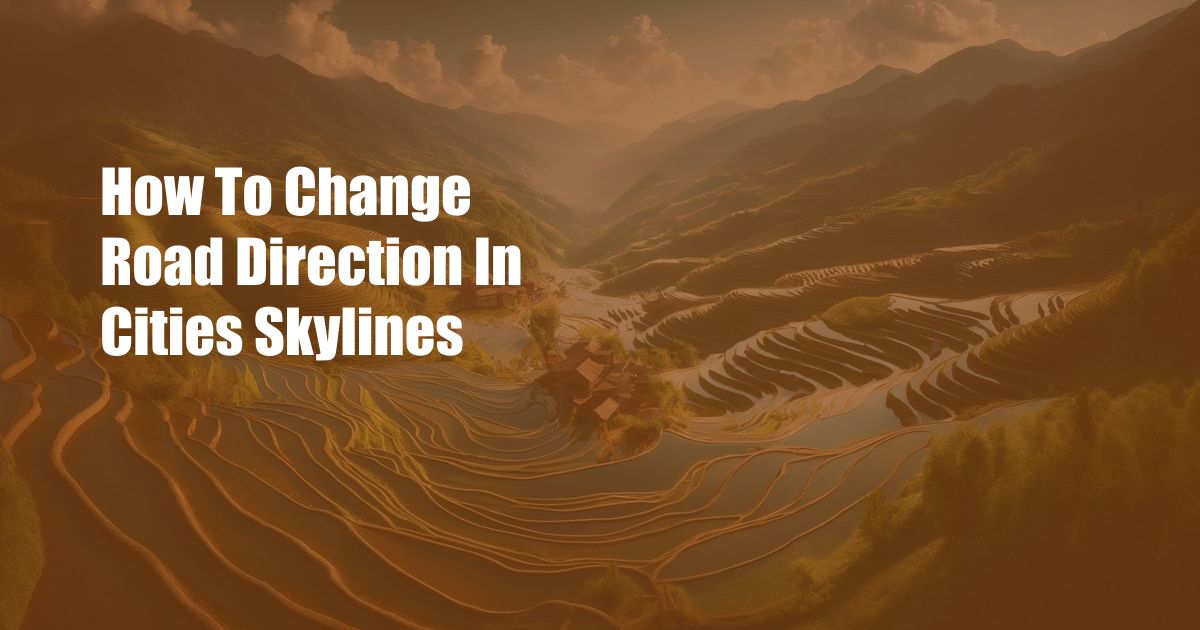
Conquering Urban Planning: A Comprehensive Guide to Changing Road Direction in Cities: Skylines
Growing the bustling metropolises of Cities: Skylines can be a rewarding endeavor, but navigating its intricate road systems can prove challenging. One pivotal aspect is altering road direction, a skill essential for creating efficient and aesthetically pleasing cities. Let’s embark on an in-depth exploration, unraveling the art of directing traffic flow and shaping your urban vision.
Directional Dominion: Controlling Traffic Flow
In the realm of Cities: Skylines, the ability to control road direction grants you unparalleled power over urban planning. By strategically aligning roads, you can regulate traffic patterns, prevent bottlenecks, and enhance overall city functionality. This intricate interplay of direction and traffic flow is a cornerstone of successful city management.
Deconstructing the Mechanics: Understanding Road Direction
Altering road direction in Cities: Skylines involves a simple yet intuitive click-and-drag mechanism. Select the road segment you wish to modify, hover your cursor over the blue arrows at its ends, and drag to rotate the road accordingly. This straightforward process empowers you to shape your city’s layout with surgical precision.
A Historical Perspective: Bridging the Past and Present
The concept of altering road direction is deeply rooted in urban planning history. From ancient Roman grid systems to the meandering streets of medieval towns, civilizations have strategically designed their roads to facilitate movement and enhance city life. In Cities: Skylines, this historical legacy translates into a powerful tool for crafting unique and functional urban landscapes.
Unlocking the Full Potential: Strategies and Best Practices
To harness the full potential of road direction, consider these expert tips:
-
Plan Ahead: Envision the flow of traffic before laying down roads. Anticipate potential bottlenecks and design intersections that minimize congestion.
-
Utilize One-Way Roads: Implement one-way roads in heavily congested areas to improve traffic flow and reduce collisions.
-
Embrace Curves and Angles: Avoid monotonous grid systems by incorporating curves and angles into your road design. This enhances aesthetic appeal and creates more dynamic driving experiences.
Foresightful Planning: Anticipating Future Developments
As your city expands and evolves, so too should your road network. Regularly assess traffic patterns and make necessary adjustments to road direction. By planning ahead, you can prevent future congestion and ensure your city remains vibrant and efficient.
A Wealth of Wisdom: Frequently Asked Questions
-
Q: Can I change the direction of a road once it has been built?
-
A: Yes, you can modify the direction of existing roads using the drag-and-drop mechanism.
-
Q: How can I prevent traffic from entering certain areas?
-
A: Utilize traffic restrictions to selectively prevent vehicles from accessing specific roads or districts.
-
Q: Is it possible to create pedestrian-only zones?
-
A: Yes, you can designate certain roads as pedestrian-only areas, prohibiting vehicular traffic.
Embracing the Urban Canvas: Conclusion
Mastering the art of changing road direction in Cities: Skylines is a fundamental skill for urban planners of all levels. By understanding the mechanics, incorporating best practices, and anticipating future developments, you can create cities that are not only efficient and functional but also visually captivating. Embark on this journey of urban design and witness the transformative power of directing traffic flow. Are you ready to become an urban maestro?

 Hogki.com Trusted Information and Education News Media
Hogki.com Trusted Information and Education News Media